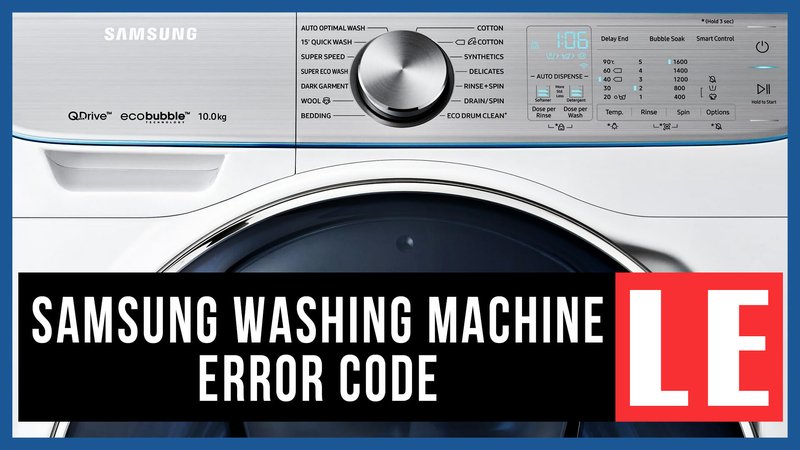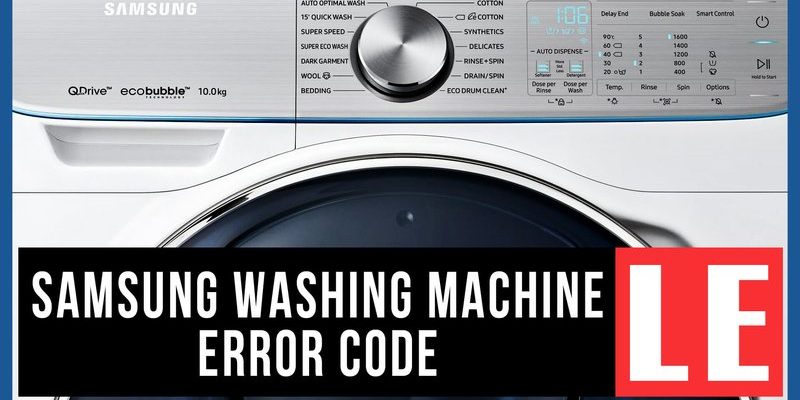
Here’s the deal: when your Samsung washing machine shows the LE error code, it’s actually trying to tell you there’s a problem—like a child pointing out a spill before you step in it. The LE code is commonly related to water leakage issues, which can feel worrying at first, especially if you’re not sure where the water might be coming from or going to. Let’s delve into what’s happening, what it means for your trusty laundry buddy, and most importantly, whether it’s still safe to use your machine when this error pops up.
Understanding the LE Error Code
So, what’s this mysterious LE code all about? Imagine your washing machine as a diligent worker—always on the lookout for anything out of the ordinary. When it detects what seems like a water leakage, it sounds the alarm by flashing the LE code. This is essentially a safeguard, much like the “check engine” light in your car.
The LE error code usually indicates there’s a leak or perceived leak somewhere in the system. This might be due to an issue with the water inlet, a loose connection, or even just an overzealous dollop of detergent causing excess suds to be identified as a leak. Picture trying to sip from a straw with a hole in it; the water’s escaping before it can reach you.
So, is it safe? Generally speaking, when your machine sounds the LE alarm, it’s best to proceed with caution. Continuing to operate the machine might exacerbate issues or lead to a small leak becoming a larger problem. However, it doesn’t necessarily mean your washing machine is beyond use—it’s more of a “pause and investigate” moment.
Causes of the LE Error Code
You might be wondering, “How did I end up with this error, and what’s causing it?” Well, there’s a handful of potential culprits. The usual suspects include issues related to water supply or drainage, or even worn-out components that need fixing. Sometimes, a simple issue with the door seal could lead to a bit of water escaping here and there during the wash cycle.
Here’s an analogy: think of your washing machine as a complex network of pipes working together in harmony. If one pipe springs a leak, the whole system’s balance is thrown off. This is often what happens behind the scenes with an LE error. It might be something as simple as a hose that’s not properly connected, or a more complex issue like a malfunctioning water level sensor.
In some cases, the problem may be due to overloading the machine. Just like trying to stuff a small suitcase with too many clothes, overloading can put undue pressure on parts of the machine, leading to leaks or other operational issues.
Once you’ve identified the possible cause, the first step in resolving the issue is to inspect the machine thoroughly. In many cases, you might be able to fix it yourself, especially if it’s a simple issue like a loose hose.
Resolving LE Error Code: Step-by-Step
Alright, so you’ve decided to roll up your sleeves and tackle this LE code head-on. Great choice! First things first, turn off the washing machine and unplug it. This is like switching the engine off before checking under your car’s hood—safety first.
Now, start with a visual inspection. Are there any obvious water leaks? Check the hoses behind your machine. These are like the veins, carrying water in and out. Sometimes, the fix is as simple as tightening a connection. Look for any signs of wear or tear on the hoses. If they seem worn out, consider replacing them.
Next, open the door and take a look at the seal. If it’s dirty or there’s a buildup of detergent and dirt, give it a good clean. Imagine cleaning your windshield to remove grime for a clearer view—same principle here. Sometimes, simply cleaning the seal can stop any small leaks.
Remember, if the problem persists and you’re unable to find a solution, it might be time to call in a professional. Though washing machines can often be fixed at home, there are instances where expert intervention is best to prevent further damage.
Prevention and Future Safety Tips
Preventing that pesky LE code from popping up in the future can save you a lot of hassle. Think of it like maintaining your car with regular oil changes—preventive care goes a long way. For starters, make sure not to overload your washing machine. Keeping things balanced ensures every part of the machine operates smoothly.
Regularly cleaning the machine, especially around the door seal and detergent drawer, keeps residue from building up and causing blockages. It’s like decluttering your space to keep things running smoothly. Also, inspect the hoses periodically, ensuring they’re securely connected and showing no signs of wear.
Another tip is to use the right amount of detergent. Just like a good recipe requires precise measurements, your washing machine works best when not overwhelmed with too many suds. Using less detergent can also reduce the chances of buildup, which can sometimes trigger the LE code.
If you remain vigilant and take these preventative measures, your washing machine will be more likely to serve you faithfully without unexpected hiccups. And remember, if ever in doubt, consult a professional to keep your machine in top condition.
